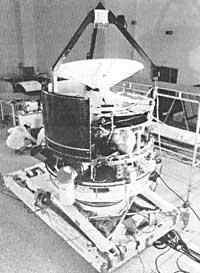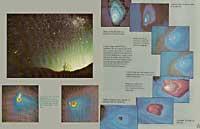Some secrets that Halley could not keep

Elhuyar. In issue 1 of Science and Technology we wrote an article about the arrival of comet Halley, commenting on theories about the nature and peculiarities of comets. On this occasion we will resume the topic to confirm or correct the said and add new data, as Giotto and other devices sent for comet tracking have sent new results.
First of all, among the results obtained, the most important is the reference to the structure and composition of comets commented in our article. It must be said that the Whipple hypothesis has been confirmed. Therefore, in Whipple's words, comets are "dirty ice" balls, and when they approach the Sun some of that ice is sublimated, but in the center there is always a solid core.
The main objectives of Halley's analysis programs were aimed at responding to three problems: the origin of the comets, the nature of the nucleus (composition) and the interactions of the comet with the interstellar medium. The instruments Giotto was carrying to collect data to answer these questions are: photo camera, mass spectrometer, dust detection sensors and ion emanations, hot plasma and measuring tools for the magnetic medium of the comet.
Also noteworthy are the data sent by the two Japanese Suisei and Sakigake probes and by the Soviets Vega 1 and 2. The latter, for their part, did an important job helping to drive towards Giotto Halley. The intention of E.A.S. was to pass to 500 km of the nucleus of the comet Giotto. For this it is necessary to know with great precision the position of the comet, with greater precision than that they could obtain measured from the Earth. The Sovie spacecraft filled this gap by sending the core positions. Thus, Giotto went through the minimum distance point at 00:03:00 (UT) on March 14, 585 km, 5 seconds after expected. This approach took place when Giotto and Halley had an opposite meaning.
Consequently, the speed of spacing compared to the dust fractions that were on the road reached 68.4 km/s, considerably increasing the force of their shocks. Some of these shocks caused the deterioration of some devices and 2 seconds before reaching the minimum distance, the Giotto suffered a series of tremors and his antenna remained 34 minutes without heading towards the Earth, leaving 605 km in that interval. However, no information was lost, as it recovered from the magnetophone of the spacecraft.
Moreover, according to the data sent by the dust sensors two unexpected conclusions can be drawn. On the one hand, the amount of dust surrounding the comet is relatively small, except in the area closest to the nucleus. Giotto's counter counted around 12000 shocks and the number of shocks was not greater than possible until 20 seconds before the maximum approach. On the other hand, the size of the fractions is also small.
The average weight of the larger fractions is 30 µg and although the impact of the first fractions occurred 70 minutes before passing through the nearest point, the second (287,000 km from the nucleus) did not reach 68 minutes later. The maximum fraction given by the counter was 40 mg. The average fractions, the size of the cigar smoke fractions, are also scarce. The first collision took place at 150000 km and did not begin to proliferate the flow until approaching 70000 km. Small fractions are less than 10 to 15 g and are the most abundant. Giotto collected a total of 150 mg of powder.
The very radio waves that Giotto sent to Earth, in addition to the information they carried, have contributed to limiting the distribution of dust, as we will see below. Of course, dust slowed Giotto's speed, and this stroking causes a shift of the Doppler effect in the reception of waves. As mentioned above, the density of the dust around the point of maximum approximation was higher. However, it was expected that the gliding would only be out of the order of 2 Hertz, but what was measured was 16 Hertz. This displacement corresponds to the 70 cm/s drop of the Giotto's speed. Therefore, we can say that: That most of the dust surrounding Halley is very close to the core.
The work of spectrometers was also excellent and the results were very interesting. The most abundant ions found are those due to water breakage H 3 O +, H 2 0 +, HO + and O + . According to estimates made from the concentration of these ions, the ice test of the comet is 58%. Carbon-nitrogen ions were also relatively abundant: CO +, CN +, N 2 O +, HCN +, CO 2 + and N 2 + . Also found were S+ and S 2+ sulfur ions and some metals: Faith +, Co +, Cu + and Ni + and Mg ++ . It also surprises the detection of mass ions of more than 100 a.m.u.a., while the detection of sodium ions is very low.
According to these data, the abundance of carbon compounds is relatively high. However, scientists expected something like that. The results obtained confirm the forecasts on the age of the kite. According to calculations made with the help of computers, 100000 years ago Halley got into the current orbit. In case of this age, a similar index was expected to have been found taking into account the losses of slaughter over years. Calculations have been confirmed.
To fully explain the structural scheme of the comet shown in Figure 1, the results obtained by the plasma sensors are analyzed.
Giotto found the first weak plasma wave and hydrogen medium nearly 8 million kilometers from the comet core. The gill wave that occurs when the solar wind and comma matter collide, passed to an approximate distance of one million kilometers. It should be noted, however, that in the case of Halley (as in the case of other kites that have been analyzed), the transition is progressively carried out in a relatively extensive region. Inside this region or langa, Giotto discovered very naughty magnetic fields and turbulent plasma currents, but in some places the flows were uniform. The magnetic field has a maximum of 16000 km.
The contact surface that cannot cross the solar wind fractions was limited to 4300 km. Under this surface we have the plasma expelled from the very cold core.
Finally, the ionopause is at an approximate distance from the nearest point of the Giotto's orbit. Inside we have a very serene region without magnetic fields.

The comet description is completed with the tails. We know that comets usually lengthen two types of tails. One, which in some cases is not seen. It forms with ions and extends radially in the opposite direction to the Sun. The other, formed by dust, is of the same direction, but slightly curved due to movement. These tails come from the impulse of the solar wind. They can be millions of kilometers and the cores are made up of sublimated matter. The measures of these losses yielded values of 12 Tm/s in December last year, 20 Tm/s in January, and 30 to 60 Tm/s in February, the day that, according to the days, passed through the perihelion (9 February), to quickly descend to 5 Tm/s in mid-March.
Let's finally analyze the most important part of the comet: the core. The photos of greater purity that Giotto took to the core show about 50 m of details, but the help of other spatial strategies was essential to delimit some characteristics of interest such as its appearance and the turning period. If we associate with these two problems, we must say that the core is not spherical as believed. Its mass is too small so that when speaking in its appearance the influence of gravity is important. Therefore, the core is shaped like a potato, with a length of 15 km and a height and depth of about 7.5 km. The rotation movement has been obtained by comparing the photos taken consecutively and has been calculated from 52.7 hours.
Vega's infrared sensors also sent information about the core temperature. Its value ranges from 300 K to 400 K. On the other hand, in order for us to have a footprint of the energy values that the comet collected, two data are: The power it received from the Sun as it passed through the Jupiter area was 44 W/m 2, while in the perihelion it was higher than 4 kW/m 2. The interpretation of the temperature and power values received generates another problem.
It is believed that the comet received enough radiation from the Sun during the study of the temperature of space installations, keeping its temperature for the whole time above 400 K. Note that a surface unit performs half the dark turning period. To overcome this contradiction, scientists have tried to find a cooling process. The phenomenon has been related to materi jets that generate the core activity. This sublimated matter would be the one that expels the heat. But let's look more closely at this activity.
The first impression is that the core activity is irregular and quite large. Therefore, the matter of different force appears in jets. As mentioned, these jets are distributed irregularly and do not total more than 10% of the surface. Another 90% is covered by a dark solid shell. And when we say dark we mean that this shell is as black as coal. Its albedo is between 0.062 and 0.04, that is, it only reflects between 2% and 4% of the light it receives.
This is another unexpected value. The nucleus was expected to be luminous and this small value of albedo caused a problem when taking the photos. Giotto's camera was programmed to follow the brightest point. Being the black core, the camera focuses on the brightest jet projected by the core. Therefore, in the photographs taken from a distance you can see the whole nucleus, but when approaching an important part was left out.
The shell, on the other hand, is very irregular and in it there are peaks and valleys, some with crater shape. But how does this dark and irregular shell arise?
It is believed that the formation process is due to the solar wind and the attraction of the gravity of the nucleus. The matter that is expelled from the core at low speed falls back to the surface, forming a parable due to the push of the solar wind and the force of gravity, which is very small. In this way, the core is in continuous remodeling and apparent change, hence its irregularity. Darkness is based on the abundance of carbon-containing compounds. Although these compounds are not structurally complicated, they are more abundant than expected, as already mentioned, and produce a greenhouse effect if the light is absorbed without letting go.
We are now able to clarify the formation of jets that explain the cooling process of the core. These originate mainly in the area of solar orientation, when the heat of radiation receiving the shell lowers and sublimates the underlying ice. This leads us to accept that the shell is quite thin, perhaps 1 cm. Giotto studied some of these jets in his approach. The longest were over 15 km and were irregularly separated. It is to be assumed, therefore, that the nucleus is not homogeneous and that in some regions there is ice under the shell and in others there are more abundant rocks. Losses of materi would occur in ice zones.
Once these jets were known, the way was opened to clarify other details that until then had no explanation. They would be the cause of the lack of uniformity of the layers surrounding the comet and its interactions with the solar wind. On the other hand, although the irregularity of the surface of the nucleus has been explained through the bombardment of the matter expelled from the nucleus, the craters observed in it come from the extraction of the jets and not from the meteorological impacts, as in the case of the Moon.
Finally, we will explain another of the particularities observed when the comet was still far from Earth: the surprising changes of luminosity. On several occasions it was observed that in a very short time (between 1 and 3 hours) Halley greatly increased its luminosity (between 3 and 5 times). These changes cannot be considered, for example, as a result of the turn. It is now believed that the phenomenon consists in the dispersion of light produced by occasional blasting powders.
As a culmination of these pages dedicated to Halley, we will mention the evaluations of the programs that scientists have made for their study. A few have made very harsh criticism that these missions have not shown news that we did not know. This is not, however, a majority opinion. In general the results are considered important, although taking into account the programs that have been organized, it must be recognized that they have not been very rich. On the other hand, two milestones stand out. The first, the good behavior of spacecraft, especially considering their harsh working conditions. The second is the international collaboration achieved. Coordination between programs has been carried out very well, which opens up new avenues for the future.







